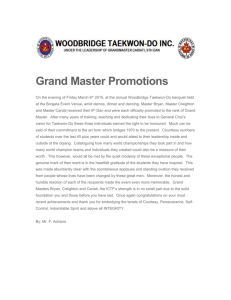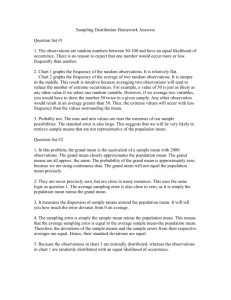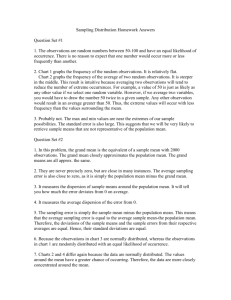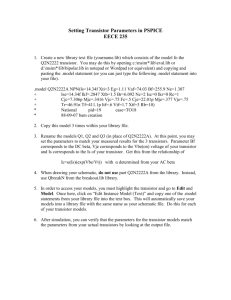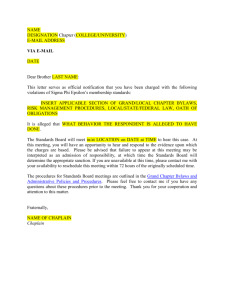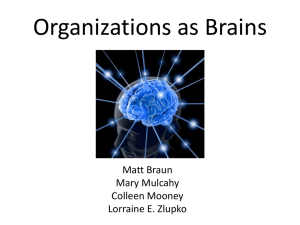Writing Assignment 2 - University of Pittsburgh
advertisement
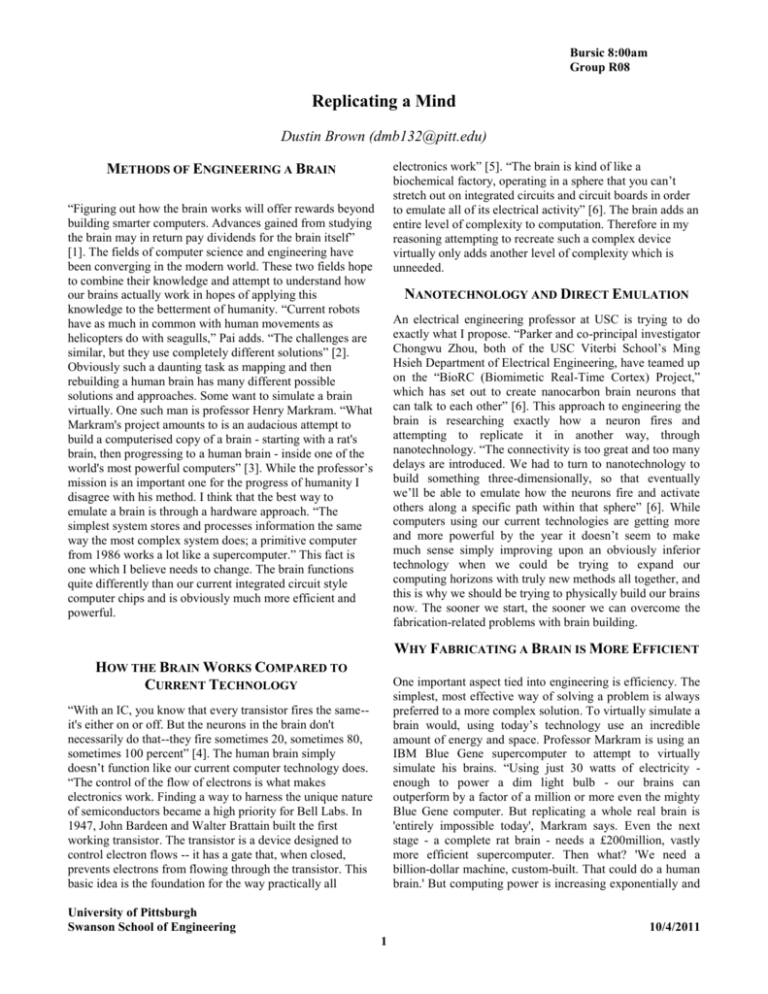
Bursic 8:00am Group R08 Replicating a Mind Dustin Brown (dmb132@pitt.edu) electronics work” [5]. “The brain is kind of like a biochemical factory, operating in a sphere that you can’t stretch out on integrated circuits and circuit boards in order to emulate all of its electrical activity” [6]. The brain adds an entire level of complexity to computation. Therefore in my reasoning attempting to recreate such a complex device virtually only adds another level of complexity which is unneeded. METHODS OF ENGINEERING A BRAIN “Figuring out how the brain works will offer rewards beyond building smarter computers. Advances gained from studying the brain may in return pay dividends for the brain itself” [1]. The fields of computer science and engineering have been converging in the modern world. These two fields hope to combine their knowledge and attempt to understand how our brains actually work in hopes of applying this knowledge to the betterment of humanity. “Current robots have as much in common with human movements as helicopters do with seagulls,” Pai adds. “The challenges are similar, but they use completely different solutions” [2]. Obviously such a daunting task as mapping and then rebuilding a human brain has many different possible solutions and approaches. Some want to simulate a brain virtually. One such man is professor Henry Markram. “What Markram's project amounts to is an audacious attempt to build a computerised copy of a brain - starting with a rat's brain, then progressing to a human brain - inside one of the world's most powerful computers” [3]. While the professor’s mission is an important one for the progress of humanity I disagree with his method. I think that the best way to emulate a brain is through a hardware approach. “The simplest system stores and processes information the same way the most complex system does; a primitive computer from 1986 works a lot like a supercomputer.” This fact is one which I believe needs to change. The brain functions quite differently than our current integrated circuit style computer chips and is obviously much more efficient and powerful. NANOTECHNOLOGY AND DIRECT EMULATION An electrical engineering professor at USC is trying to do exactly what I propose. “Parker and co-principal investigator Chongwu Zhou, both of the USC Viterbi School’s Ming Hsieh Department of Electrical Engineering, have teamed up on the “BioRC (Biomimetic Real-Time Cortex) Project,” which has set out to create nanocarbon brain neurons that can talk to each other” [6]. This approach to engineering the brain is researching exactly how a neuron fires and attempting to replicate it in another way, through nanotechnology. “The connectivity is too great and too many delays are introduced. We had to turn to nanotechnology to build something three-dimensionally, so that eventually we’ll be able to emulate how the neurons fire and activate others along a specific path within that sphere” [6]. While computers using our current technologies are getting more and more powerful by the year it doesn’t seem to make much sense simply improving upon an obviously inferior technology when we could be trying to expand our computing horizons with truly new methods all together, and this is why we should be trying to physically build our brains now. The sooner we start, the sooner we can overcome the fabrication-related problems with brain building. WHY FABRICATING A BRAIN IS MORE EFFICIENT HOW THE BRAIN WORKS COMPARED TO CURRENT TECHNOLOGY One important aspect tied into engineering is efficiency. The simplest, most effective way of solving a problem is always preferred to a more complex solution. To virtually simulate a brain would, using today’s technology use an incredible amount of energy and space. Professor Markram is using an IBM Blue Gene supercomputer to attempt to virtually simulate his brains. “Using just 30 watts of electricity enough to power a dim light bulb - our brains can outperform by a factor of a million or more even the mighty Blue Gene computer. But replicating a whole real brain is 'entirely impossible today', Markram says. Even the next stage - a complete rat brain - needs a £200million, vastly more efficient supercomputer. Then what? 'We need a billion-dollar machine, custom-built. That could do a human brain.' But computing power is increasing exponentially and “With an IC, you know that every transistor fires the same-it's either on or off. But the neurons in the brain don't necessarily do that--they fire sometimes 20, sometimes 80, sometimes 100 percent” [4]. The human brain simply doesn’t function like our current computer technology does. “The control of the flow of electrons is what makes electronics work. Finding a way to harness the unique nature of semiconductors became a high priority for Bell Labs. In 1947, John Bardeen and Walter Brattain built the first working transistor. The transistor is a device designed to control electron flows -- it has a gate that, when closed, prevents electrons from flowing through the transistor. This basic idea is the foundation for the way practically all University of Pittsburgh Swanson School of Engineering 10/4/2011 1 Dustin Brown it is only a matter of time before suitable hardware is available” [3]. While Markram may be right in saying that the technology he requires will be realized in the next decade it will definitely not be very efficient or practical. [3]. ENDING THOUGHTS While the task of reverse engineering the brain is indisputably important in the world of engineering and in the world in general the approach taken is important as well. I think by trashing everything we know about computation and starting anew with a hardware-based decoding strategy will in the end have far greater rewards than simply pouring more money into making old, less efficient technology. REFERENCES [1] (2011) “Reverse-Engineer the Brain.” National Academy of Engineering Grand Challenges for Engineering, [Online Article]. Available: http://www.engineeringchallenges.org/cms/8996/9109.aspx [2] (2008, June 12) “Reverse Engineering the Brain To Model Mind-Body Interactions” Science Daily, [Online: Article]. Available: http://www.sciencedaily.com/releases/2008/06/080612080431.htm [3] (2010, Jan. 4) M. Hanlon. “The Real Frankenstein Experiment: One Man’s Mission to Create a Living Mind Inside a Machine.” Mail Online, [Online Article]. Available: http://www.dailymail.co.uk/sciencetech/article1240410/The-real-Frankenstein-experiment-One-mans-mission-createliving-mind-inside-machine.html [4] (2008, June) S. Adee. “Reverse Engineering the Brain.” IEEE Spectrum Science Forum, [Online Article]. Available: http://spectrum.ieee.org/biomedical/ethics/reverse-engineering-the-brain [5] J. Strickland, “How Moore’s Law Works.” How Stuff Works, [Online Article]. Available: http://computer.howstuffworks.com/moores-law1.htm [6] (2009, Feb. 12) “How Do You Build a Synthetic Brain?” Science Daily, [Onine Article]. Available: http://www.sciencedaily.com/releases/2009/02/090211194151.htm ADDITIONAL SOURCES B. Amadei. “Engineering for the Developing World.” National Academy of Engineering Grand Challenges for Engineering. [Online Article]. Available: http://www.engineeringchallenges.org/cms/7126/7356.aspx (2011) “Introduction to the Grand Challenges for Engineering.” National Academy of Engineering Grand Challenges for Engineering. [Online Web site]. Available: http://www.engineeringchallenges.org/cms/8996/9221.aspx (2008, Feb. 20) A. Revkin. “How Many ‘Grand’ Challenges Are Really Policy Challenges?” The New York Times: The Opinion Pages. [Online Article]. Available: http://dotearth.blogs.nytimes.com/2008/02/20/howmany-grand-engineering-challenges-are-really-policy-challenges/ S. Unger, “Responsibility in Engineering: Victor Paschkis vs Wernher von Braun.” IT Professional, Volume 12 Issue 3, 2010, p. 6-7, DOI 10.1109/MITP.2010.94 ACKNOWLEDGMENTS Ptolemy, Robert dir. Transcendent Man. Ptolemaic Productions, 2009. Film. University of Pittsburgh Swanson School of Engineering 10/4/2011 2
